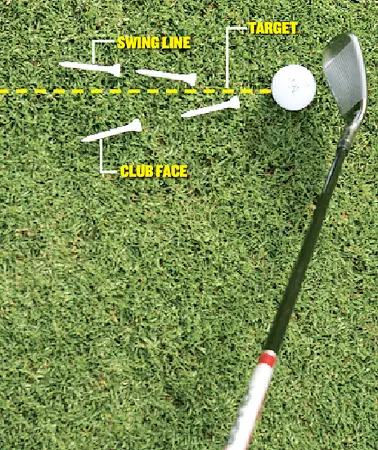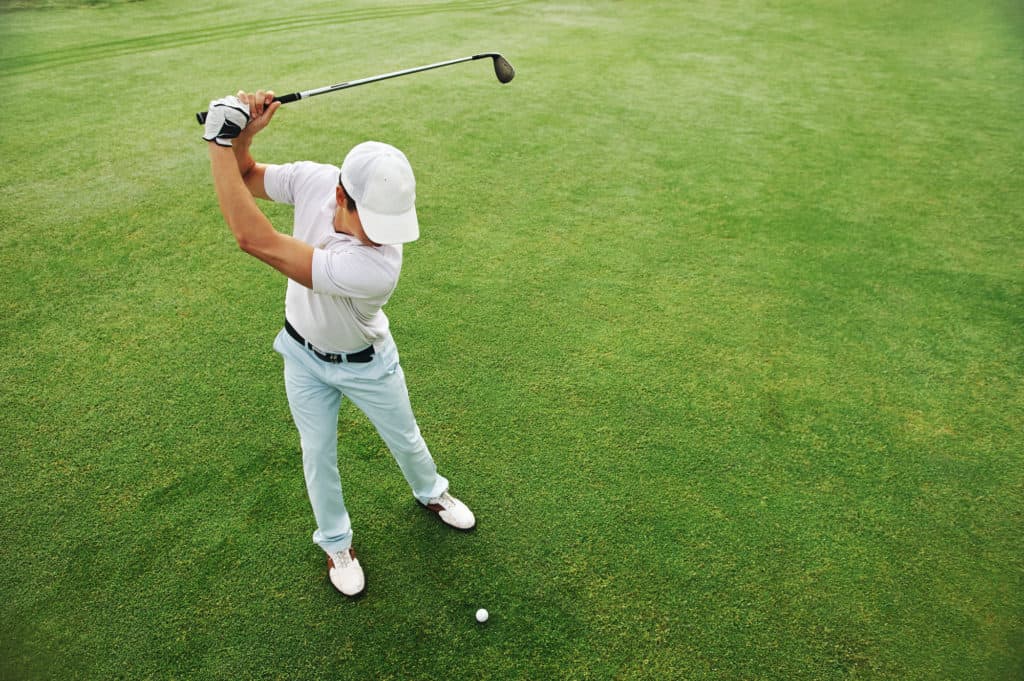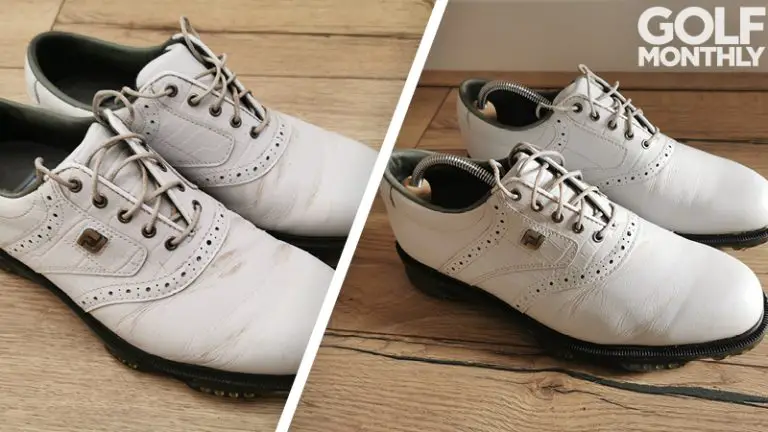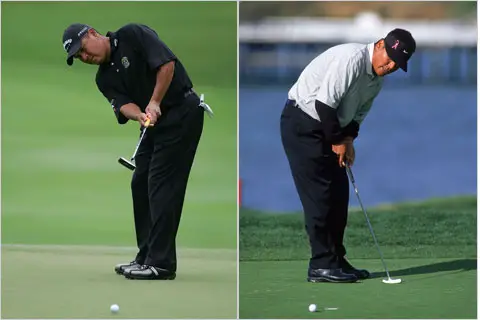How To Hit A 6 Iron

If you’re looking to enhance your golf game, mastering the art of hitting a 6 iron is a fundamental skill that can significantly improve your performance on the course. The 6 iron is a versatile club that provides a balance between distance and control, making it an essential tool for golfers of all skill levels.
In this comprehensive guide, we will delve into the key techniques, tips, and strategies to help you hit a 6 iron with confidence, accuracy, and consistency. Whether you’re a beginner looking to establish a strong foundation or an experienced player aiming to refine your skills, this guide will provide you with the knowledge and guidance you need to excel with the 6 iron.
From the proper grip and setup to the mechanics of the swing, we will break down each component and discuss the essential elements required to strike the ball cleanly and achieve the desired distance and trajectory. We will explore the importance of body alignment, ball position, and swing tempo, as well as delve into shot shaping techniques and strategies for optimizing your performance with a 6 iron.
Throughout the guide, we will provide practical tips, drills, and practice exercises to help you develop a consistent and effective 6 iron game. Whether you’re facing a long approach shot, navigating a tight fairway, or aiming for precision on par-3 holes, mastering the 6 iron will give you the confidence and ability to tackle a variety of on-course challenges.
Get ready to elevate your golf game as we dive into the intricacies of how to hit a 6 iron with precision and finesse. Let’s unlock the full potential of this versatile club and take your golfing skills to new heights!

Understanding the 6 Iron: Club Design and Characteristics
The 6 iron is a versatile club that finds its place in various situations on the golf course. Before we delve into the techniques, let’s understand the design and characteristics of a 6 iron that make it unique.
The 6 iron is a mid-iron club with a moderate loft, typically ranging from 26 to 30 degrees. It falls between the higher-lofted irons (such as the 9 iron and pitching wedge) and the lower-lofted irons (such as the 3 iron and 4 iron). The length of the 6 iron is slightly longer than the higher-lofted wedges but shorter than the longer irons. This combination of loft and length makes the 6 iron suitable for shots requiring a balance of distance and control.
The clubhead of a 6 iron is typically made of stainless steel or other materials, and it features a cavity-back design. The cavity-back design redistributes the weight of the clubhead to the perimeter, providing forgiveness and stability on off-center hits. This design helps golfers achieve more consistent results and reduces the negative effects of mishits.
Understanding these characteristics of the 6 iron will give you a better appreciation of its capabilities and enable you to use it effectively in different situations on the golf course.
Mastering the Grip and Setup: Foundation for Success
To hit a 6 iron with precision and accuracy, it’s crucial to establish a solid grip and proper setup. The grip is your connection to the club, and the setup positions your body for an effective swing. Let’s explore the key elements of grip and setup that will provide a foundation for success.
Grip
A proper grip sets the stage for a controlled and fluid swing. Here are the key steps to achieve a correct grip for a 6 iron:
- Placement: Hold the club in your left hand (for right-handed golfers) with the grip running diagonally across your palm, just below the pad of your index finger. The club should extend diagonally across the base of your fingers towards the bottom of your palm.
- Placement of Thumb: Wrap your left hand’s thumb around the grip, resting it slightly to the right of the centerline (towards the right side of the grip for right-handed golfers). The thumb should point towards the target.
- Interlocking or Overlapping: Place your right hand on the grip, overlapping or interlocking your right pinky finger with the gap between your left index finger and middle finger. The grip should fit comfortably in your right hand, with the thumb resting on the left side of the grip.
- Alignment: Ensure that the Vs formed by your thumbs and index fingers point towards your right shoulder (for right-handed golfers). This alignment promotes a square clubface at impact.
A correct grip promotes control, stability, and proper wrist movement throughout the swing. Practice your grip to develop a comfortable and consistent hold on the club.
Setup
The setup is crucial for proper alignment, balance, and body positioning. Here’s how to set up for a 6 iron shot:
- Feet Position: Stand with your feet shoulder-width apart, parallel to the target line and slightly flared out. Position the ball in the center of your stance, aligning it with the middle of your body.
- Weight Distribution: Distribute your weight evenly on both feet, with a slight bias towards your front foot. This promotes a downward strike and helps maintain balance throughout the swing.
- Body Alignment: Align your body parallel to the target line. Check your alignment by placing a club or alignment stick on the ground, pointing towards the target. Position your feet, hips, and shoulders parallel to the alignment stick.
- Knee Flex: Bend your knees slightly to establish an athletic and balanced stance. This flexion in the knees allows for better weight transfer and helps generate power through the swing.
- Spine Angle: Maintain a slight tilt in your spine towards the ball. This tilt ensures that your hands are positioned ahead of the ball, promoting a descending strike.
A proper setup ensures that you start the swing with a solid foundation and in a position to make a consistent and powerful strike. Practice your setup to develop a comfortable and repeatable stance for hitting your 6 iron.
Swing Mechanics and Body Alignment: Achieving Consistency
Executing a successful 6 iron shot requires proper swing mechanics and body alignment. Let’s break down the key components of the swing and discuss how to align your body for optimal contact and control.
Backswing
The backswing sets the stage for a powerful and controlled downswing. Here are the key elements to focus on during the backswing:
- Takeaway: Start the clubhead by rotating your shoulders and turning your torso away from the target. Keep your wrists firm but not rigid, allowing for a smooth and controlled takeaway.
- Arm and Wrist Position: As you complete the backswing, your lead arm (left arm for right-handed golfers) should be parallel to the target line. At the top of the backswing, your wrists should be fully hinged, creating a 90-degree angle between the clubshaft and your lead forearm.
- Shoulder Turn: Focus on turning your shoulders to create a coil and generate power. A full shoulder turn helps create the necessary torque for a powerful downswing.
Downswing
The downswing is where the power and accuracy of your 6 iron shot are generated. Here’s how to execute a proper downswing:
- Weight Transfer: Initiate the downswing by shifting your weight onto your front foot. This transfer of weight helps create a descending strike and promotes ball-first contact.
- Hip Rotation: As you transfer your weight, rotate your hips towards the target. This rotation adds power and allows for proper sequencing of the swing.
- Maintaining Lag: Maintain the angle between your lead forearm and the clubshaft as you approach impact. This lag generates clubhead speed and ensures a crisp strike on the ball.
- Follow-Through: Extend your arms fully and rotate your body towards the target as you complete the follow-through. Maintain a balanced finish position with your weight predominantly on your front foot.
Body Alignment
Proper body alignment ensures that your swing path is on target and promotes consistent contact with the ball. Here’s how to align your body for a 6 iron shot:
- Parallel Alignment: Align your feet, hips, and shoulders parallel to the target line. Use an alignment stick or a visual reference point to check your alignment before each shot.
- Aim Point: Choose a specific target or aim point in the distance to focus your alignment. This could be a spot on the fairway, a specific area on the green, or a target marker.
- Visual Alignment: Visualize an imaginary line extending from the ball to your target. Align the club face perpendicular to this line, ensuring that it is square to the target at address.
- Square Shoulders: Keep your shoulders parallel to the target line throughout the swing. Avoid any excessive rotation or tilt that may lead to an inconsistent swing path.
By focusing on proper swing mechanics and body alignment, you’ll develop a more consistent and repeatable swing with your 6 iron. Practice these elements to ingrain them into your muscle memory and improve your overall ball-striking ability.
Ball Position and Stance: Finding the Sweet Spot
The position of the ball in your stance and the width of your stance play a crucial role in hitting a 6 iron effectively. Let’s explore the ideal ball position for a 6 iron shot and how it affects the trajectory and distance of the ball. We’ll also discuss the importance of a balanced and stable stance to ensure a solid foundation for your swing.
Ball Position
The position of the ball in your stance influences the angle of attack and the clubface at impact. For a 6 iron shot, the ball should be positioned slightly ahead of the center of your stance. Here are some guidelines to help you find the ideal ball position:
- Centered Stance: Begin with a centered stance, placing the ball in line with the middle of your stance.
- Ball Forward: Move the ball slightly forward in your stance, around 1-2 ball-widths ahead of center. This promotes a slightly ascending strike, maximizing the club’s loft and launching the ball with an optimal trajectory.
- Experimentation: Adjust the ball position within this range to find the position that works best for you. Experimenting with different ball positions can help you optimize your launch angle and control the flight of the ball.
Stance Width
A stable and balanced stance provides a solid foundation for a controlled swing. Here’s how to establish the proper stance width for hitting a 6 iron:
- Shoulder-Width Stance: Begin with a stance that is approximately shoulder-width apart. This width provides stability while allowing for proper weight transfer during the swing.
- Comfort and Balance: Find a stance width that feels comfortable and allows you to maintain balance throughout the swing. Experiment with slightly wider or narrower stances to find the width that suits your body type and swing style.
Maintaining a consistent and balanced stance, along with proper ball position, will help you strike the ball cleanly and achieve the desired trajectory and distance with your 6 iron.
Controlling Distance and Accuracy: Factors to Consider
Hitting a 6 iron with distance and accuracy requires an understanding of the factors that influence the ball’s flight. In this section, we’ll discuss the impact of clubhead speed, angle of attack, and center-face contact on distance and accuracy. We’ll also provide tips and techniques to help you control these factors and consistently hit your target with your 6 iron.
Clubhead Speed
Clubhead speed is a critical factor in achieving distance with a 6 iron. Here are some tips to help you generate more clubhead speed:
- Proper Technique: Focus on executing a smooth and fluid swing with proper sequencing of the body and arms. A well-coordinated swing generates more speed and power.
- Maintain Tempo: Avoid rushing the downswing or swinging too aggressively. Maintain a consistent tempo and rhythm throughout the swing for optimal clubhead speed.
- Strength and Flexibility: Engage in regular strength and flexibility training exercises to improve your overall swing speed. Building strength in your core, legs, and arms can positively impact your clubhead speed.
Angle of Attack
The angle of attack refers to the direction in which the clubhead strikes the ball relative to the ground. It plays a crucial role in the trajectory and distance of your 6 iron shots. Here’s what you need to know about angle of attack and how to optimize it:
- Descending Strike: Aim for a slightly descending strike with your 6 iron to maximize both distance and control. This means striking the ball before the lowest point of your swing arc, creating a divot after impact.
- Ball-First Contact: Focus on hitting the ball first, then taking a divot. This ensures clean contact and allows you to compress the ball, resulting in a higher launch and more distance.
- Shallow Angle: Avoid excessively steep angles of attack, as this can lead to thin or topped shots. Instead, strive for a shallow angle of attack that allows the clubhead to sweep through the ball with a descending motion.
- Body Rotation: Proper body rotation plays a role in optimizing the angle of attack. Ensure that your hips rotate towards the target in the downswing, allowing your hands to lead the clubhead into impact.
Achieving the right angle of attack takes practice and a focus on proper technique. Experiment with your swing and seek feedback from a golf instructor if needed to fine-tune your angle of attack with the 6 iron.
Center-Face Contact
Consistently hitting the sweet spot of your 6 iron is crucial for both distance and accuracy. Here’s why center-face contact is important and how you can improve it:
- Energy Transfer: The sweet spot of the clubface is designed to transfer energy efficiently to the ball. Hitting the sweet spot ensures maximum transfer of energy, resulting in more distance.
- Consistent Ball Flight: Center-face contact promotes a consistent ball flight, reducing the likelihood of shots veering off to the left or right. It helps you maintain control and accuracy with your 6 iron.
- Impact Factors: Pay attention to your hand-eye coordination, swing path, and body positioning to achieve center-face contact. Consistently practicing your swing and focusing on the fundamentals will help you develop a more consistent impact.
Improving your ability to strike the ball in the center of the clubface will enhance your overall performance with the 6 iron. Regular practice and conscious attention to your impact position will contribute to improved distance and accuracy.
Shot Shaping: Working the Ball with a 6 Iron
Having the ability to shape your shots with a 6 iron can provide valuable options on the golf course. In this section, we’ll explore shot shaping techniques such as fades and draws, and how to execute them with a 6 iron. We’ll discuss the clubface and swing path adjustments needed to achieve different shot shapes, allowing you to navigate various course conditions and situations.
Fade
A fade is a controlled shot that curves gently from left to right (for right-handed golfers). Here’s how to execute a fade with your 6 iron:
- Grip Adjustment: Slightly weaken your grip by rotating both hands to the left (for right-handed golfers). This means turning your hands slightly counter-clockwise on the grip.
- Clubface Alignment: Align the clubface slightly left of your target. The open clubface at address promotes a fade shot.
- Swing Path: Maintain a swing path that moves slightly across the target line from outside to inside. This promotes the left-to-right curvature of the fade.
- Body Alignment: Align your body slightly to the left of the target to accommodate the fade shot shape.
Executing a fade shot with a 6 iron requires practice and a focus on the necessary adjustments to your grip, clubface alignment, swing path, and body alignment.
Draw
A draw is a controlled shot that curves gently from right to left (for right-handed golfers). Here’s how to execute a draw with your 6 iron:
- Grip Adjustment: Slightly strengthen your grip by rotating both hands to the right (for right-handed golfers). This means turning your hands slightly clockwise on the grip.
- Clubface Alignment: Align the clubface slightly right of your target. The closed clubface at address promotes a draw shot.
- Swing Path: Maintain a swing path that moves slightly from inside to outside of the target line. This promotes the right-to-left curvature of the draw.
- Body Alignment: Align your body slightly to the right of the target to accommodate the draw shot shape.
Executing a draw shot with a 6 iron requires practice and a focus on the necessary adjustments to your grip, clubface alignment, swing path, and body alignment.
Practice Drills and Tips: Improving Your 6 Iron Game
To enhance your skills with a 6 iron, consistent practice and focused drills are essential. In this section, we’ll share some effective drills and tips that will help you improve your distance, accuracy, and overall proficiency with a 6 iron.
Alignment and Target Practice
- Use alignment sticks or clubs to create visual references for proper alignment during practice sessions. This will help develop a consistent setup and promote accurate shots.
- Set up targets at various distances and practice hitting your 6 iron to those targets. Focus on accuracy and distance control, adjusting your swing as needed.
Tempo and Rhythm
- Practice swinging your 6 iron with a metronome or by counting out a steady rhythm in your head. This will help develop a smooth and consistent tempo, resulting in more controlled shots.
- Focus on maintaining a balanced and smooth swing throughout the entire motion. Avoid rushing or forcing the swing, and let the club do the work.
Shot Trajectory Control
- Experiment with different swing lengths and tempos to control the trajectory of your 6 iron shots. Practice hitting low-trajectory punch shots and high-trajectory shots to develop versatility in different course conditions.
- Use a variety of targets, such as markers on the range or on the course, to practice hitting your 6 iron with different trajectories. This will help you adapt to different wind conditions and course layouts.
On-Course Simulation
- Create realistic on-course scenarios during practice by simulating different lies, such as uphill, downhill, and sidehill lies. Practice adjusting your setup and swing to accommodate these challenging situations.
- Play practice rounds on the course focusing solely on using your 6 iron. This will give you valuable experience in club selection, shot shaping, and course management with your 6 iron.
By incorporating these practice drills and tips into your training regimen, you’ll develop a stronger and more confident game with your 6 iron.
Conclusion
The 6 iron is a versatile club that can help you achieve both distance and accuracy on the golf course. By understanding the key principles and techniques discussed in this guide, you’ll be able to hit your 6 iron with confidence and consistency.
Remember to focus on the grip, setup, swing mechanics, and body alignment to establish a solid foundation for your shots. Practice regularly and experiment with different shots and trajectories to develop a well-rounded game with your 6 iron.
With dedication, patience, and the right approach, you’ll soon be hitting your 6 iron with precision, achieving impressive distances, and enjoying the rewards of a well-executed shot. So get out there, practice, and watch your 6 iron game soar to new heights!






